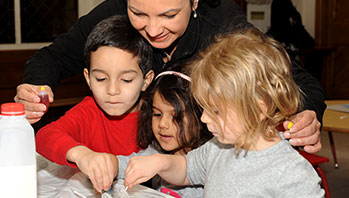- a variety of cardboard tubes including cardboard tubes from toilet paper, paper towels, and wrapping paper
- flexible tubing such as hoses from shop vacs, vacuum cleaners or sump pumps
- paper and pencil
- plastic
- predict
- sound
- tube
MA Standards:
English Language Arts/Speaking and Listening/SL.PK.MA.1 Participate in collaborative conversations with diverse partners during daily routines and play.
MA Draft STE Standards:
Physical Sciences/Matter and Its Interactions/PS4.A Investigate different sounds made by different objects and different materials and reason about what is making the sounds. [Cause and Effect]
Head Start Outcomes:
Logic and Reasoning/Reasoning and Problem Solving Recognizes cause and effect relationships.
Logic and Reasoning/Reasoning and Problem Solving Classifies, compares, and contrasts objects, events, and experiences.
PreK Learning Guidelines:
Science and Technology/Inquiry Skills 1 Ask and seek out answers to questions about objects and events with the assistance of interested adults.
Science and Technology/Inquiry Skills 2 Make predictions about changes in materials or objects based on past experience.
Small Group: Tube Sounds

© Commonwealth of Massachusetts, Department of Early Education and Care (Jennifer Waddell photographer). All rights reserved.
STEM Key Concepts: Sounds sound different when they travel through a hollow object
ELA Focus Skills: Listening and Speaking, Vocabulary, Making Connections, Fine Motor Skills
Join small groups of children at the Science and Math Center as they continue to explore listening to the sounds around them through tubes. Add flexible tubing to the materials and encourage children to compare the sounds they hear through it to the sounds they hear using the cardboard tubes.
As children explore, notice what captures their attention and, when appropriate, engage them in conversation, asking them to talk about what they are doing and/or what they are noticing and wondering. Ask,
- What do you predict will happen to a sound when you move the tube away from your ear? Why do you think so? What actually happens to the sound?
- Do sounds sound the same through the cardboard and plastic tubes? Why do you think they sound the same/different?
- What is the most interesting sound you can make with the tubes? What do you like about that sound?
Jot down children’s comments and questions as they continue to explore listening through tubes. Encourage children to explain what they are observing using the new key concept vocabulary.
Take It Further: You may want to record some of the children’s observations and the words they use to describe their observations. Ask other children to listen to the recordings and try to recreate the sounds they hear. Have them use their own words to describe the sounds.
